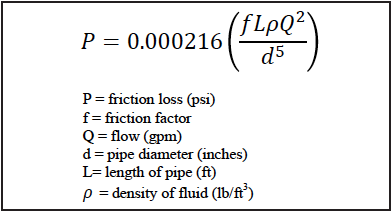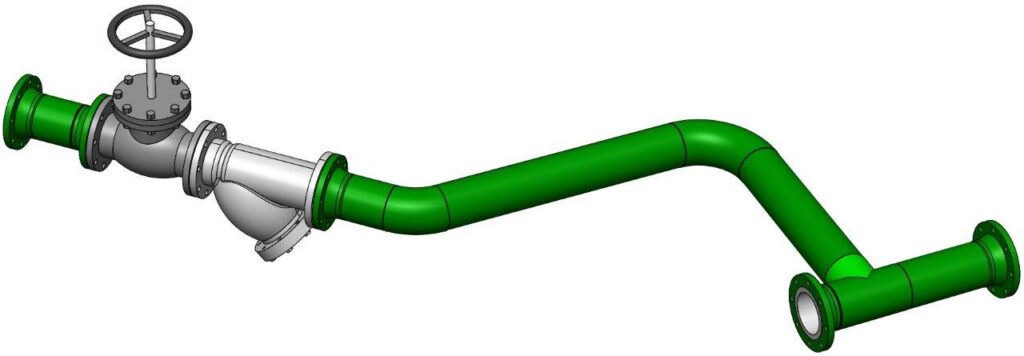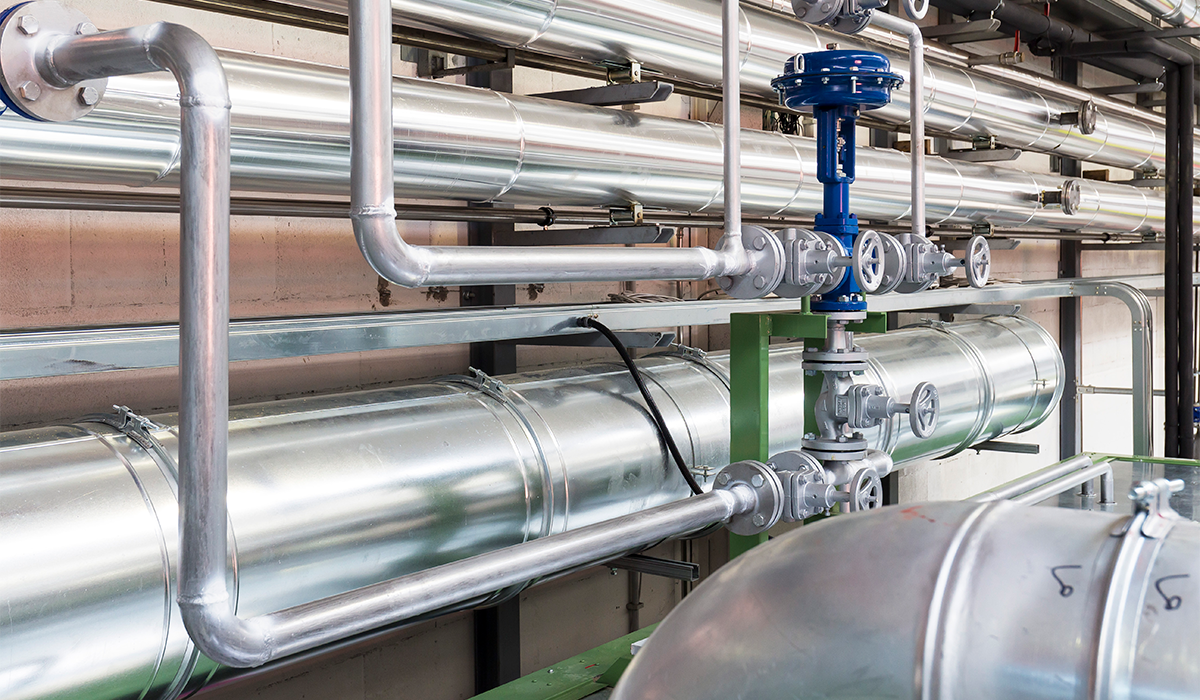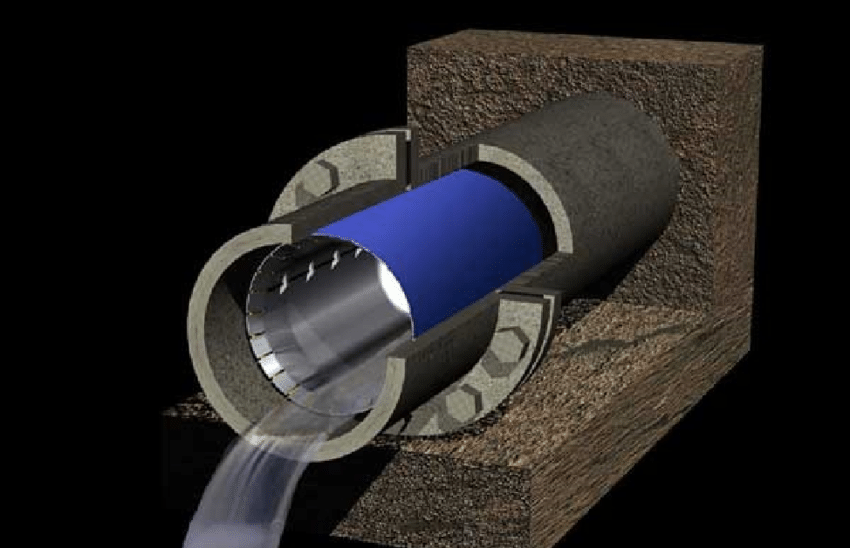Piping is the use of pipes, valves, fittings, and other components to transport liquids, gases, and other fluid substances. Piping systems are used in a wide range of applications, including water supply and distribution, heating, ventilation, air conditioning (HVAC), and industrial processes. Pipe friction loss is an important aspect.
Piping design involves the selection and arrangement of the components of a piping system to meet the needs of the specific application, including the transportation of fluids, the control of fluid flow, and the protection of the fluid from contamination and corrosion. It also involves consideration of the safety, reliability, and efficiency of the piping system, as well as its ability to withstand the loads imposed on it, including thermal, fluid-borne, and wind loads.
The design of a piping system involves several key steps, including the selection of materials, the routing of pipes, the determination of fluid flow, and the calculation of the loads imposed on the system. Designers must also consider the effects of thermal expansion and contraction, fluid dynamics, and fluid pressure, as well as the effects of changes in temperature and pressure with height.
A well-designed piping system is essential for the safe and efficient operation of a building or industrial process. It must be able to withstand the loads imposed on it and transport fluids efficiently, while ensuring the protection of the fluid from contamination and corrosion. The design of a piping system must be carefully considered and well-documented to ensure its functionality, safety, and efficiency.
Pipe Friction Loss
Pipe friction loss refers to the pressure drop that occurs as fluid flows through a piping system. This pressure drop is caused by the friction between the fluid and the walls of the pipe, which slows down the fluid and reduces its pressure. The amount of friction loss depends on several factors, including the fluid properties, the pipe diameter, the fluid velocity, and the roughness of the pipe wall.
Pipe friction loss is often expressed in terms of head loss, which is the pressure drop in terms of the height of a column of fluid. The head loss is proportional to the length of the pipe and the square of the fluid velocity. The larger the diameter of the pipe, the lower the friction loss, while the higher the fluid velocity, the higher the friction loss. The roughness of the pipe wall also affects the friction loss, with smoother pipes resulting in lower friction loss.

The head loss can be calculated using the Darcy-Weisbach equation, which takes into account the fluid properties, the pipe diameter, the fluid velocity, and the roughness of the pipe wall. The equation can be used to predict the head loss for a given pipe length and fluid velocity, which can be useful in designing a piping system to meet the needs of a specific application.
In practice, the head loss is often represented using a friction factor, which is a dimensionless number that represents the resistance to fluid flow. The friction factor is used to determine the head loss for a given pipe length and fluid velocity, taking into account the effects of the fluid properties, pipe diameter, and pipe roughness.
It is important to consider the effects of pipe friction loss in the design of a piping system, as the pressure drop can affect the performance of the system and the safety of the fluid being transported. To minimize the friction loss, designers can use larger diameter pipes, lower fluid velocities, and smoother pipe wall finishes, as well as select materials with low roughness and appropriate fluid properties.
In conclusion, pipe friction loss is an important aspect of piping design, as it affects the pressure drop and performance of the piping system. By considering the effects of friction loss in the design of a piping system, designers can ensure that the system meets the needs of the application and operates safely and efficiently.
Science behind Pipe Friction Loss
The science behind pipe friction loss is based on the laws of fluid mechanics and the principles of fluid-wall interaction. As fluid flows through a pipe, it encounters resistance from the walls of the pipe, which slows down the fluid and reduces its pressure. This resistance is known as pipe friction loss.
The main cause of pipe friction loss is the shear stress between the fluid and the pipe wall. The shear stress arises due to the viscosity of the fluid, which slows down the fluid near the pipe wall and creates a friction force. The frictional force depends on the fluid velocity, the viscosity of the fluid, and the roughness of the pipe wall.
The friction loss can be calculated using the Darcy-Weisbach equation, which takes into account the fluid properties, the pipe diameter, the fluid velocity, and the roughness of the pipe wall. The equation can be used to predict the head loss for a given pipe length and fluid velocity, which can be useful in designing a piping system to meet the needs of a specific application.
In practice, the head loss is often represented using a friction factor, which is a dimensionless number that represents the resistance to fluid flow. The friction factor is used to determine the head loss for a given pipe length and fluid velocity, taking into account the effects of the fluid properties, pipe diameter, and pipe roughness.

It is important to consider the effects of pipe friction loss in the design of a piping system, as the pressure drop can affect the performance of the system and the safety of the fluid being transported. To minimize the friction loss, designers can use larger diameter pipes, lower fluid velocities, and smoother pipe wall finishes, as well as select materials with low roughness and appropriate fluid properties.
In conclusion, pipe friction loss is a fundamental aspect of fluid mechanics and a crucial consideration in the design of piping systems. By understanding the science behind pipe friction loss and applying appropriate design techniques, designers can ensure that the piping system operates safely and efficiently, delivering fluid at the required pressure and flow rate.
Consequences of Pipe Friction Loss
Pipe friction loss can have a significant impact on the performance and efficiency of a piping system. Some of the consequences of pipe friction loss include:
- Pressure drop: The main consequence of pipe friction loss is a decrease in fluid pressure as the fluid flows through the piping system. The pressure drop can reduce the performance of the system and may affect the delivery of fluid to the end-use.
- Energy loss: The pressure drop caused by pipe friction loss requires additional energy to maintain the fluid flow, which results in increased energy consumption and costs.
- Flow rate reduction: The pressure drop can also reduce the fluid flow rate, which may impact the performance of the system and the delivery of fluid to the end-use.
- System efficiency: Pipe friction loss can also affect the overall efficiency of the piping system, as it increases the energy consumption and reduces the fluid flow rate.
- Pipe corrosion: The friction between the fluid and the pipe wall can cause turbulence and pressure fluctuations, which can lead to corrosion and degradation of the pipe material.
- Increased maintenance: The consequences of pipe friction loss, such as pressure drop and reduced flow rate, can result in increased maintenance requirements and costs.
In conclusion, pipe friction loss can have a significant impact on the performance, efficiency, and maintenance of a piping system. It is important to consider the consequences of pipe friction loss in the design of a piping system and to minimize the friction loss through appropriate design techniques and materials selection.
Preventive Measures

There are several measures that can be taken to prevent or minimize pipe friction loss in a piping system:
- Pipe diameter: Increasing the pipe diameter is one of the most effective ways to reduce pipe friction loss. Larger diameter pipes result in lower fluid velocity, which in turn reduces the friction loss.
- Smooth pipe surfaces: The roughness of the pipe wall affects the friction loss, with smoother pipe surfaces reducing the friction loss. Piping systems can be designed using materials with low roughness, such as plastic or coated metal pipes.
- Low fluid velocity: Reducing the fluid velocity is another way to reduce pipe friction loss. By reducing the fluid velocity, the shear stress between the fluid and the pipe wall is reduced, which in turn reduces the friction loss.
- Appropriate fluid properties: Selecting fluid properties that are appropriate for the application can also reduce pipe friction loss. Fluids with lower viscosity result in lower friction loss, so it is important to choose a fluid with the appropriate viscosity for the application.
- Pipe routing: The routing of the piping system can also affect the friction loss. By avoiding sharp turns and reducing the number of fittings and valves, the friction loss can be minimized.
- Flow control devices: The use of flow control devices, such as flow meters and control valves, can also help to reduce pipe friction loss. These devices can be used to regulate the fluid velocity and pressure, which in turn reduces the friction loss.
In conclusion, there are several measures that can be taken to prevent or minimize pipe friction loss in a piping system. By taking a holistic approach to the design and implementation of the piping system, it is possible to minimize the friction loss and ensure that the piping system operates safely and efficiently.
Conclusion
Pipe friction loss is an important factor to consider in the design and operation of a piping system. It is the result of the fluid flowing through a pipe and the friction between the fluid and the pipe wall. The consequences of pipe friction loss include pressure drop, energy loss, reduced flow rate, decreased system efficiency, increased maintenance requirements, and pipe corrosion.
There are several measures that can be taken to minimize pipe friction loss, such as selecting a larger pipe diameter, using smoother pipe surfaces, reducing fluid velocity, selecting appropriate fluid properties, optimizing pipe routing, and using flow control devices. By considering these measures in the design and operation of the piping system, it is possible to minimize friction loss and ensure the safe and efficient operation of the system.

In conclusion, proper design and implementation of measures to minimize pipe friction loss are crucial for the safe and efficient operation of a piping system. The impact of friction loss on the performance, efficiency, and maintenance of the system should be carefully considered in the design and operation of any piping system.





